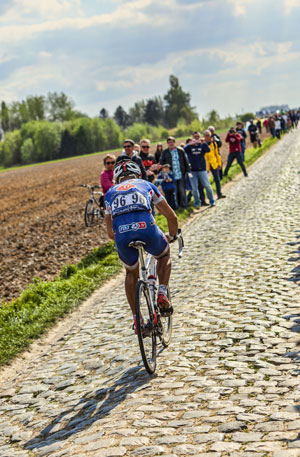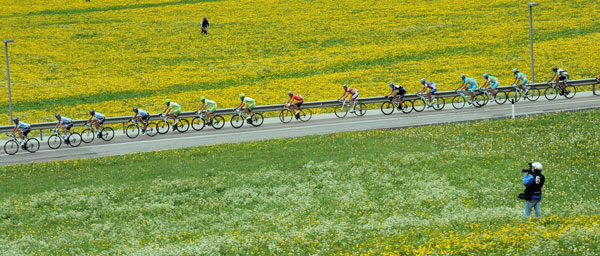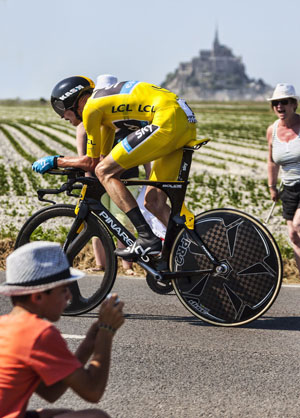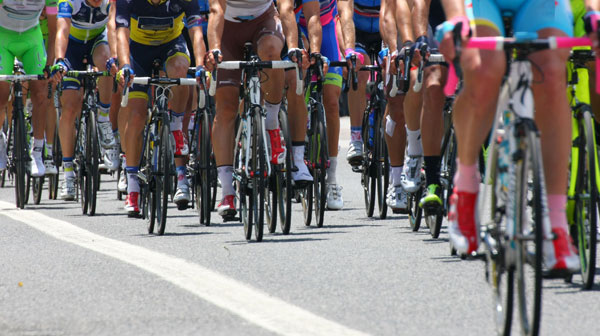With the 2015 professional season now underway, Iain Treloar runs you through the classic cycling races worth losing sleep over.
To casual viewers, the men’s professional cycling calendar has been dominated by a select few races. Until recently, this was because broadcast options for Australian viewers were limited, with the season pivoting around the biggest race in the world, the Tour de France. But with a boom in the popularity of the sport of cycling across Australia, led by landmark achievements such as Cadel Evans’ 2011 Tour de France victory and top performances from riders including Simon Gerrans, it’s becoming increasingly clear to Australian sports fans that there’s a whole season of cycling worth watching. It may be a jam-packed schedule, but with timezone differences being what they are, we’ve gone through and cherry-picked the pivotal races worth going out of your way for.
The monuments
Dotted throughout the season, the so-called ‘monuments of cycling’ are evocative, fiercely-contested one-day races with rich histories. The routes take riders through scenic and testing terrain; the winners of these races attain legendary status. Happily for the sleep-patterns of Australian viewers, the monuments fall on weekends, and are usually screened live by SBS.
Milan – San Remo, aka la Primavera, is on 22 March in 2015. At just shy of 300km, Milan – San Remo is a big day in the saddle. Falling early in the European spring, it’s frequently bitterly cold adding to the test for riders. The 2013 edition was shortened by heavy snowfall, and the 2014 edition was conducted in spirit-sapping rain and hail. The course is relatively flat, often coming down to a bunch sprint, but a series of short climbs in the final quarter of the race add an extra level of difficulty. As such, it’s not necessarily one for the pure sprinters, with classics specialists like Simon Gerrans and Fabian Cancellara tasting success in recent years, alongside fast men like Alexander Kristoff and Mark Cavendish. This race only starts getting really interesting in the dying stages, so it’s a long late one for Australian viewers watching the action.
Tour of Flanders, aka Ronde van Vlaanderen, is on 5 April in 2015. One of the most exciting races of the season, the Tour of Flanders is a cobbled classic held in the north of Belgium. Although the country has a reputation as being generally flat, this race takes in iconic climbs along quiet farm roads and is often decided by attacks late in the race. The short sharp nature of the cobbled climbs, paired with double-digit gradients, favour powerful and technically-skilled riders such as Fabian Cancellara and Peter Sagan; their 2013 duel up the Paterberg was one of the highlights of that year’s racing. For my money, the Tour of Flanders is one of the most exciting races in the calendar, although in Australia it’s overshadowed somewhat by the notorious Paris – Roubaix.
 Paris – Roubaix, aka the Hell of the North, is on 12 April in 2015 (Easter Sunday). It’s probably the best known of the classics here; it’s both rich in history, and has seen Australian success with Stuart O’Grady’s 2007 victory. Despite its name, the race doesn’t actually start in Paris any more, instead kicking off in Compiegne before winding north for 250-ish kilometres. The race comprises a relatively uneventful flat 100km to begin with, before all hell breaks loose in the hallowed Forest of Arenberg—a straight passage of notoriously poor cobbled road, taken at full speed, where the peloton splinters into the contenders and the also-rans. The 20+ cobbled sections of the race—counted down as the race progresses—are graded in level of difficulty, with five star segments being absolute boneshakers. Paris – Roubaix is notable for the technological innovation that it inspires; not so long ago, it wasn’t uncommon to see suspension on some bikes, and even now many riders opt for cyclocross or endurance road bikes rather than their conventional race machines to tackle the course. There’s been a run of dry, dusty editions in recent years, but a wet ‘true’ Paris – Roubaix is an enthralling mud-spattered spectacle.
Paris – Roubaix, aka the Hell of the North, is on 12 April in 2015 (Easter Sunday). It’s probably the best known of the classics here; it’s both rich in history, and has seen Australian success with Stuart O’Grady’s 2007 victory. Despite its name, the race doesn’t actually start in Paris any more, instead kicking off in Compiegne before winding north for 250-ish kilometres. The race comprises a relatively uneventful flat 100km to begin with, before all hell breaks loose in the hallowed Forest of Arenberg—a straight passage of notoriously poor cobbled road, taken at full speed, where the peloton splinters into the contenders and the also-rans. The 20+ cobbled sections of the race—counted down as the race progresses—are graded in level of difficulty, with five star segments being absolute boneshakers. Paris – Roubaix is notable for the technological innovation that it inspires; not so long ago, it wasn’t uncommon to see suspension on some bikes, and even now many riders opt for cyclocross or endurance road bikes rather than their conventional race machines to tackle the course. There’s been a run of dry, dusty editions in recent years, but a wet ‘true’ Paris – Roubaix is an enthralling mud-spattered spectacle.
Liege – Bastogne – Liege, aka la Doyenne, will be held on 26 April this year. Liege-Bastogne-Liege is the oldest of the monuments, having first run in 1892. The race is held in the Ardennes—the hilly north of Belgium—and like the Roubaix, has a reputation as one of the toughest of the classics. Hills, cobbles and its 270km+ length make it an exceptionally difficult day in the saddle. Liege – Bastogne – Liege favours punchy riders like Daniel Martin and Simon Gerrans (last year’s winner); purer climbers can also get lucky, with the now-retired Andy Schleck taking the spoils in 2009.
Giro di Lombardia, aka The Race of the Falling Leaves, is on 4 October in 2015. The Giro di Lombardia is a hilly classic held in the north of Italy, late in the season. For all of these reasons it’s something of an oddity amongst the classics; the profile is simply too tough for the flat classics riders to excel, opening it up to contenders like Joaquim Rodriguez and his ilk. It’s a fantastically beautiful race, winding around Lake Como and over picturesque climbs like the Madonna del Ghisallo, through dusty Italian hamlets and autumn trees.

Minor classics
Outside of the five ‘monuments’, there are a number of minor classics that offer intriguing racing. Many of these are important indicators of form in the lead up to the better-known monuments, whilst others are intriguing stand-alone races deserving of greater recognition. Some of these fall mid-week, which makes them a less appealing proposition to stay up for, but if you’re okay being a bit bleary the next day, SBS Cycling Central’s website usually has decent-quality English-language streaming of these races.
Strade Bianche (7 March 2015) is a relatively recent race, first held in 2007, which covers around 200km through Tuscany. The race was designed as a precursor to the cobbled classics of Paris – Roubaix and Tour of Flanders and, as such, favours similar riders. The unique proposition of the Strade Bianche is revealed in its name, which Italian speakers will recognise as indicating ‘white roads’; more specifically, gravel. Good bike handlers are able to excel in these conditions, and it makes for compelling viewing.
Gent – Wevelgem (29 March 2015) falls bang in the middle of the traditional classics season, taking in cobbles and hills. The course isn’t quite selective enough to shed all the sprinters, which usually means it comes down to a sprint from a small group.
Amstel Gold (April 19 2015) The only race in the calendar to take its name entirely from a pretty uninspiring beer, Amstel Gold is a rare Dutch classic in a season dominated by Belgian ones. Situated in Limburg, the lumpy, southernmost province of the Netherlands, the course takes in a relentless string of short but steep climbs, of increasing frequency as the finish line approaches. The final climb of the race, the famous Cauberg, serves as a crucial launching pad for the decisive attack.
La Fleche Wallonne (22 April 2015) is another Belgian classic. It is not overly severe in length or parcours, but the closing kilometres are a nailbiter. The opening section of the race, starting in Charleroi, is an intermittently interesting eastward run to Huy. After this, the peloton does three laps of a closing circuit incorporating the fearsome Mur de Huy, one of cycling’s most famous battlegrounds. The race concludes at the top of the Mur, with the surviving riders attacking each other up gradients of up to 26% to the finish line.
Clasica de San Sebastian (1 August 2015) is a somewhat overlooked race conducted in the Basque region of Spain. It’s one for the climbers. Having previously decided that the course wasn’t selective enough, the organisers now opt for two ascents of the Alta de Jaizkibel, an 8km climb at 5.6%, closely followed by the 2km Alto de Arkale (first kilometre averaging a painful 12.6%, the second 9.5%), before an exciting plunge to the finish that rewards the brave.
Short tours
Keep an eye open for streams of the Tour of Romandie (Switzerland, late April to early May), Tour of California (USA, late May), and Criterium du Dauphine (France, mid June), all important precursors to the Tour de France and vital indicators of form. Last year, the Dauphine provided the enthralling battle between Alberto Contador and Chris Froome that we missed out on in the Tour.
The Grand Tours
Grand tours follow a three week stage-racing format, with a mix of sprint, mountain and time trial stages. In Australia, SBS will screen all stages of the Giro d’Italia and Tour de France live for 2015.  The Vuelta a España was, in 2014, only screened here as a half-hour daily highlights package; for 2015, SBS will screen “up to 12 stages”, with details to be confirmed later in the year.
The Vuelta a España was, in 2014, only screened here as a half-hour daily highlights package; for 2015, SBS will screen “up to 12 stages”, with details to be confirmed later in the year.
Giro d’Italia 9 – 31 May 2015 The Tour might have all the prestige, but the Giro d’Italia is often a more challenging race. This year’s route takes in nine days of climbing with six mountain-top finishes, and a greater amount of time-trialling than usual. The Giro is the cycling fan’s grand tour.
Tour de France 4 – 26 July 2015 Generations of Australian riders have fallen in love with cycling through the Tour de France, and it remains the biggest annual sporting event in the world. The 2015 edition promises to be a gripping battle between this year’s thwarted contenders, Chris Froome and Alberto Contador. Add defending champion Vincenzo Nibali and Nairo Quintana to the mix, and it’s set to be a thriller.
Vuelta a España 22 August – 13 September 2015 is the final grand tour of the season, and a brutally tough one. However, with the more prestigious Giro and Tour overshadowing it, there’s far less coverage, and for many riders it’s something of a second priority for the season. This year’s course takes in nine completely new summit finishes, and what has been described as the toughest climbing stage in grand tour history on stage 11.
Ride On content is editorially independent, but is supported financially by members of Bicycle Network. If you enjoy our articles and want to support the future publication of high-quality content, please consider helping out by becoming a member.

